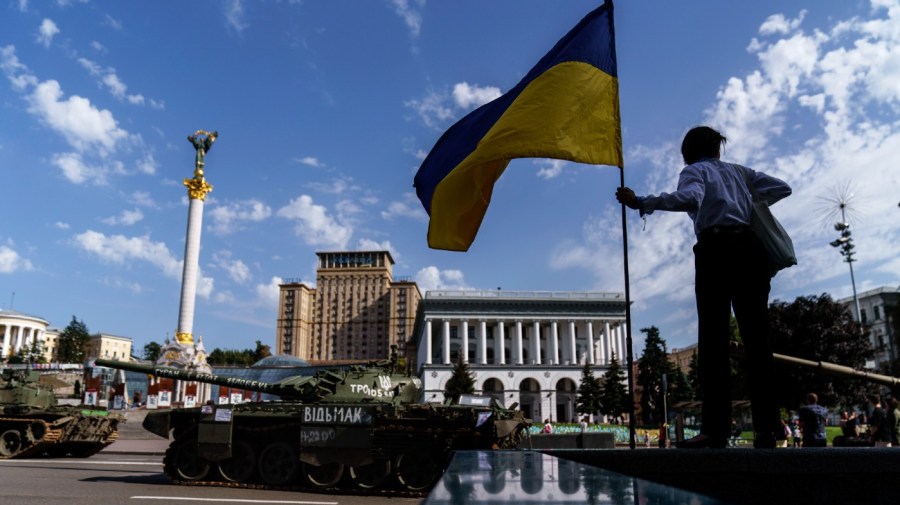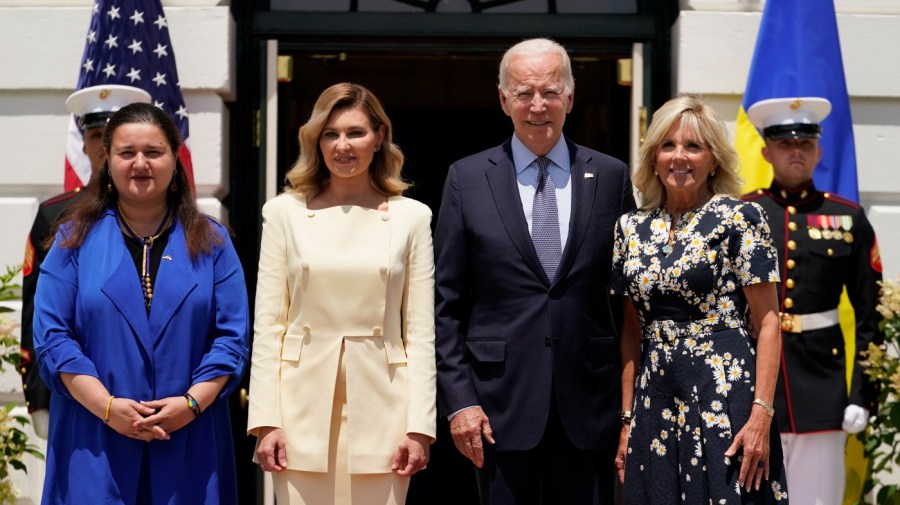Ukraine marks tense Independence Day hoping for more US help against Russia
KYIV, Ukraine – Ukraine will mark a tense Independence Day on Wednesday — an anniversary that also represents the six-month mark since a Russian invasion plunged the country into a war for its survival.
Ukrainians are resolute and determined to continue the fight, but the threat of heavy bombardment and the uncertainty of the war’s direction weighs heavily on the population.
Russian strikes and violence on Independence Day are a distinct possibility. Kyiv has banned public celebrations given stepped up attacks by Russia against Ukraine’s civilian population and military targets.
Ukrainian officials and international diplomats have been advised to telework on Wednesday given the increased threats, while the State Department has warned Americans in the country to depart immediately.
Interviews conducted with Ukrainian commanders near front line positions and with Ukrainian and international officials in Kyiv suggest the war has reached a critical crossroads six months after Russian forces first invaded on Feb. 24.
The war could drag on into at least the next year, pinning Ukraine’s hopes this Independence Day on continued support from the United States, where the conflict has faded to an extent from the news cycle. Questions also have been raised about how the midterm elections might impact U.S. support, which so far has largely been bipartisan.
“The fate of Europe rests on 25 HIMARS, and 200 extra Howitzers,” Oleksii Arestovych, an adviser to the office of Ukrainian President Volodymyr Zelensky, said in an interview with The Hill in Kyiv on Tuesday, referring to the U.S.-provided High Mobility Artillery Rocket Systems that have emerged as a key part of the U.S. assistance.
“Maybe it will sound very standard, but it’s from the bottom of my heart: we are extremely grateful to [the United States]. … Many people are saying we’re brave fighters, and that’s the truth – but we wouldn’t exist already if there was no support from the U.S. Literally, the U.S. saved and is saving Ukraine. It’s not a metaphor, it’s a clear truth.”
An estimated 16 U.S.-delivered HIMARS are in Ukraine and being used to devastating effect, according to Ukrainian and U.S. officials. Arestovych said that in 10 days, Ukrainian forces managed to take out 50 Russian arms depots using the weapons.

Ukrainians also have been buoyed by key military successes that have disrupted the Russian military’s sense of security behind its offensive line. These include sabotage and subterfuge; the destruction of arms depots, military supply lines and command and control posts; and the killing of top Russian military officials, although not all attacks have been confirmed as being carried out by Ukraine.
Tensions were inflamed this week when a car bomb in Moscow killed the daughter of a prominent Russian nationalist. Russia has accused Ukraine of being behind the attack, which Kyiv has denied.
Overall, Ukrainians are battling exhaustion and fatigue. Soldiers are killed or wounded daily in the grind of front line fighting and civilians all over the country live under constant threat of Russian missile attacks.
The losses on both sides are difficult to pinpoint because neither side has consistently provided casualty figures. The commander of Ukraine’s military said this week that some 9,000 Ukrainian soldiers have died in the invasion. Russia has suffered heavy losses – an estimated 70,000 Russian troops are believed wounded or killed in the fighting, according to U.S. figures.
According to the United Nations, over 5,500 civilians have been killed and nearly 8,000 injured in Ukraine since the start of the war, though those figures are likely undercounted.
While Ukraine’s air defense system has improved in its ability to intercept attacks, daily air raid sirens implore Ukrainians to seek shelter as the few Russian rockets that make it through inflict immense and devastating damage.
In Mykolaiv, a southern river-port city, Russian missiles struck buildings of the Black Sea University twice in two days – on August 16 and 18 – ripping off the face of the entrance and shattering the windows of small houses across the street. On a visit by The Hill a day after the attack, the damage was so fresh a computer monitor dangled from its power cord from a second story, still attached to the outlet ripped from the wall.

The Ukrainian defense looks to be approaching a crescendo for a counter-offensive in the South, centered around the river city of Kherson. Retaking Kherson would allow Ukraine’s armed forces to better hit Russia’s military bases in the occupied Crimean Peninsula and Moscow’s fleet in the Black Sea.
“What we are witnessing now is a war of attrition, and the front line has moved very little over the last couple of weeks,” the European Union’s ambassador to Ukraine, Matti Maasikas, said in an interview with The Hill from his office in Kyiv on Tuesday.
“Whereas Ukrainians are increasingly capable of hitting targets way behind the front line, that has an effect on the Russian logistics, first of all, but should have an effect on Russia’s morale.”
He also said attacks on Crimea, which Russia invaded and then annexed from Ukraine in March 2014, are having an effect.
“I mean, Crimea was considered safe. Crimea was boosted to be an unsinkable flagship carrier. Ain’t no more,” Maasikas said.
Moscow has failed in its primary objective to decapitate Kyiv and subsume the Ukrainian people. But Russian President Vladimir Putin has continued his military campaign, focusing on the eastern parts of the country that border Russia. The White House warned last month that Moscow was laying the groundwork to try to annex more Ukrainian territory, possibly in timing with September regional elections in Russia.
Zelensky has said he wants to retake all territory occupied by Russia, including the Donbas and Crimea, though he also said he was open to negotiations.
Arestovych said that Russia must be dealt a serious military defeat before any fruitful negotiations can take place.
“If we defeat them, if they lose in two, three major battles on the battlefield they will be much easier to talk to during the negotiations, and then we will have a real chance to have a proper agreement with them,” he said.
“Without such, two, three, four major losses on the battlefield, they will try to relaunch the same activities.”
Arestovych said he is following how Ukraine is covered in western and international media, and has noted how it often falls in priority to domestic stories.
He noted that President Biden announced $775 million in new U.S. assistance to Ukraine last week on the same day that Turkish President Recep Tayyip Erdoğan visited with Zelensky in Lviv.
“It was a sign of the real American position. I don’t see America getting tired of the situation in Ukraine,” he said.
The Associated Press reported on Tuesday that the U.S. is prepared to announce an additional roughly $3 billion in security aid to train and equip Ukrainian forces for what may be a long fight.

Ukrainian fighters in interviews near the front lines echo the calls for more HIMARS from the U.S.
In a small village near the front line with Kherson, “Chute,” a Ukrainian battalion commander identified by his call-sign, told The Hill that the increased focus of Ukrainian troops on the southern front has forced Russia to redirect its resources and move its troops away from the battlefield in the east.
“For us, it becomes easier to control the front line,” he said through a translator.
He added that 50 HIMARS would help in strengthening Ukrainian forces — about 20 have arrived in the country — and that more missiles are needed.
Chute said his battalion has held the front line for three weeks and has tried to push the Russians back, “but the problem was the feeling that we don’t have enough artillery, they have more,” he said. Russian strikes along the front line are imprecise, but he said they make up for this with massive quantities of artillery volleys.
“Every day there is an incident” at the front line, he said, alluding to soldiers killed and wounded.
He said with more Western-provided precision weaponry, alongside the necessary electronic and surveillance warfare being conducted through drones, his battalion could carry out more successful hits of Russian tanks, armored personnel carriers and stockpiles.
“We just need the high precision weapons. It’s hard for us to hit, directly, the Russian ammunition because we have just a few high-precision weapons. We understand that it’s expensive, but it pays for itself. And our people are highly motivated, they are ready.”
Morgan Chalfant contributed
This story was updated at 10:23 on Aug. 24.
Copyright 2023 Nexstar Media Inc. All rights reserved. This material may not be published, broadcast, rewritten, or redistributed.

